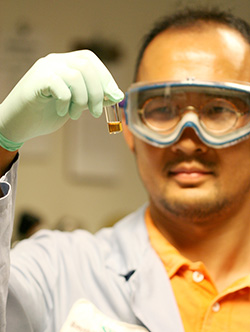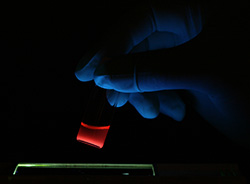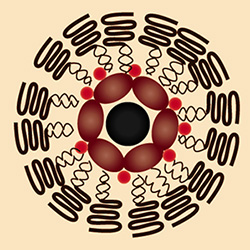February 21, 2011 by Lisa Zyga

Electroluminescence image of a four-inch full-color quantum dot display with a resolution of 320 x 240 pixels. Image credit: Tae-Ho Kim, et al. ©2011 Macmillan Publishers Limited.
(PhysOrg.com) -- For more than a decade, researchers have been trying to make TV displays out of quantum dots. Theoretically, quantum dot displays could provide extremely high-resolution images and higher energy efficiencies than current TVs. Now in a new study, researchers have presented the first large-area, full-color quantum dot display that could lead to the development of displays for the next-generation TVs, mobile phones, digital cameras, and portable game systems.
The researchers, Tae-Ho Kim and coauthors from various institutes in South Korea, have published their study on the first four-inch, full-color quantum dot display in a recent issue of Nature Photonics. The display consists of a film printed with trillions of the tiny quantum dots (an average of 3 trillion per cm2). The quantum dots emit light at a specific wavelength (color) that can be tuned by changing the size of the quantum dots.
Previous attempts to make full-color quantum dot displays have faced challenges in that image quality tended to decrease with the size of the display. To overcome this challenge, the researchers in the current study used a different method for applying the quantum dots to the film’s surface. Instead of spraying the quantum dots onto the film, the researchers created an “ink stamp” out of a patterned silicon wafer. They used the stamp to pick up strips of size-selected quantum dots, and then stamp them onto the substrate. Unlike the spraying methods, this method does not require the use of a solvent, which previously reduced color brightness.
As the results showed, the new quantum dot display has a greater density and uniformity of quantum dots, as well as a brighter picture and higher energy efficiency than previous quantum dot displays. The new display is also flexible, so applications could include roll-up portable displays or flexible lighting applications. The technology could also be used in photovoltaic devices, which would especially benefit from quantum dots’ high energy efficiency.
February 21, 2011 by Lisa Zyga

Electroluminescence image of a four-inch full-color quantum dot display with a resolution of 320 x 240 pixels. Image credit: Tae-Ho Kim, et al. ©2011 Macmillan Publishers Limited.
(PhysOrg.com) -- For more than a decade, researchers have been trying to make TV displays out of quantum dots. Theoretically, quantum dot displays could provide extremely high-resolution images and higher energy efficiencies than current TVs. Now in a new study, researchers have presented the first large-area, full-color quantum dot display that could lead to the development of displays for the next-generation TVs, mobile phones, digital cameras, and portable game systems.
The researchers, Tae-Ho Kim and coauthors from various institutes in South Korea, have published their study on the first four-inch, full-color quantum dot display in a recent issue of Nature Photonics. The display consists of a film printed with trillions of the tiny quantum dots (an average of 3 trillion per cm2). The quantum dots emit light at a specific wavelength (color) that can be tuned by changing the size of the quantum dots.
Previous attempts to make full-color quantum dot displays have faced challenges in that image quality tended to decrease with the size of the display. To overcome this challenge, the researchers in the current study used a different method for applying the quantum dots to the film’s surface. Instead of spraying the quantum dots onto the film, the researchers created an “ink stamp” out of a patterned silicon wafer. They used the stamp to pick up strips of size-selected quantum dots, and then stamp them onto the substrate. Unlike the spraying methods, this method does not require the use of a solvent, which previously reduced color brightness.
As the results showed, the new quantum dot display has a greater density and uniformity of quantum dots, as well as a brighter picture and higher energy efficiency than previous quantum dot displays. The new display is also flexible, so applications could include roll-up portable displays or flexible lighting applications. The technology could also be used in photovoltaic devices, which would especially benefit from quantum dots’ high energy efficiency.
More information: Tae-Ho Kim, et al. “Full-colour quantum dot displays fabricated by transfer printing.” Nature Photonics. DOI:10.1038/nphoton.2011.12.
via: Nature News

 2 to
2 to 

